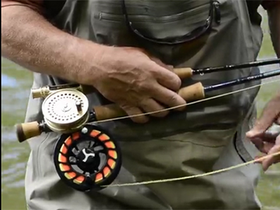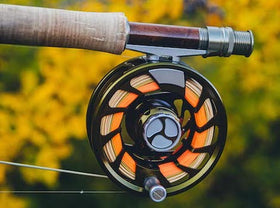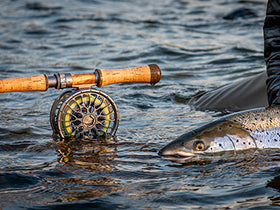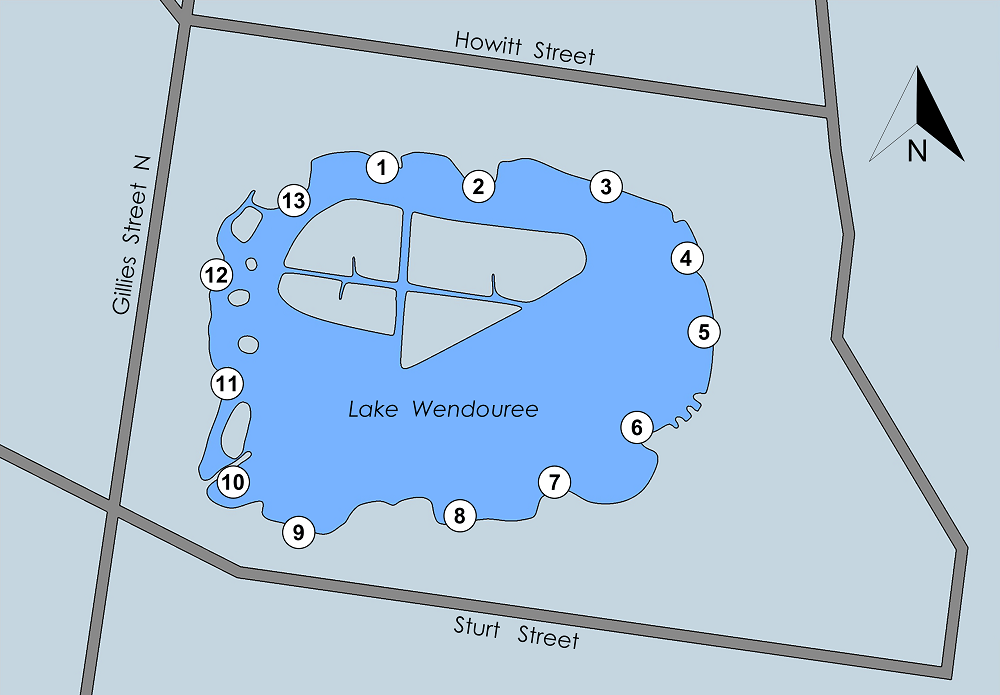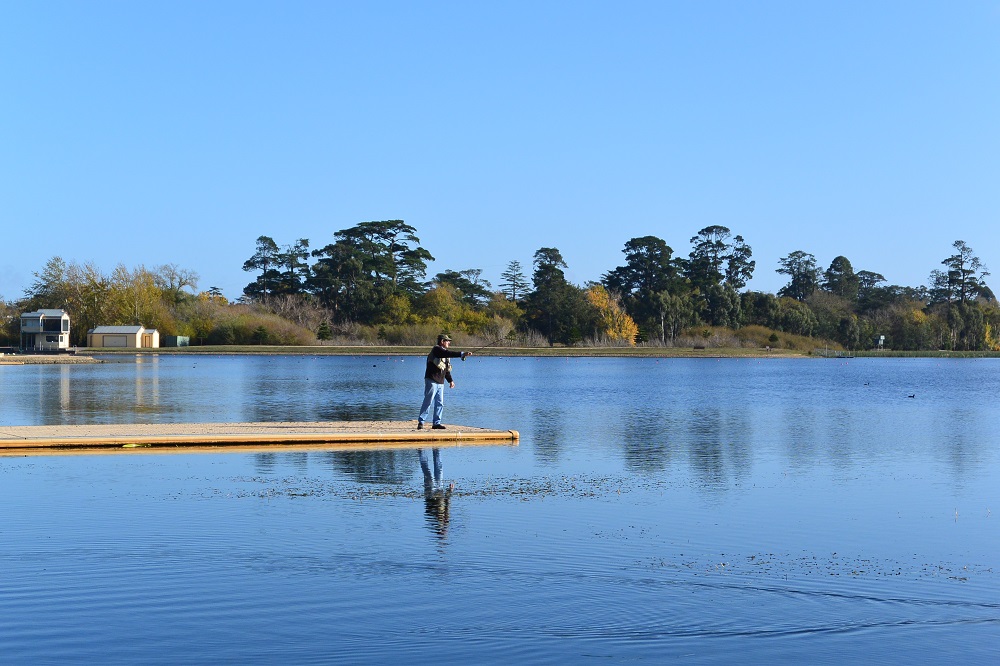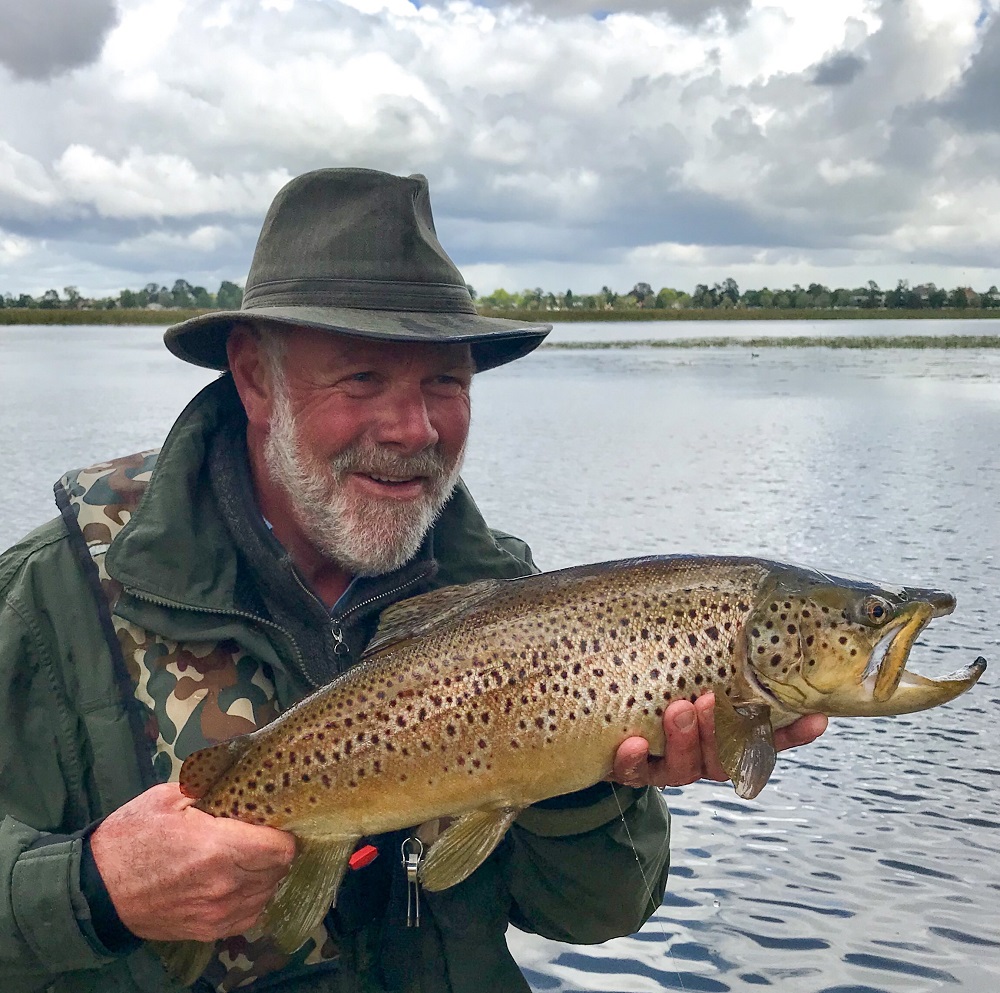Craig describes the many bank fishing locations on this central Victorian lake.
Lake Wendouree is one of Victoria’s most unusual trout fisheries, being located in the heart of the city of Ballarat. Unlike most urban venues, at 215 hectares and with nearly 6km of shoreline, it’s certainly a ‘proper’ lake rather than an ornamental pond. And surprisingly, given its setting, Wendouree is usually very clear and aquatic flora and fauna thrive.
Lake Wendouree has been stocked with trout ever since 1870, soon after the Ballarat Fish Acclimatisation Society was formed. The exception has been the few years when the lake was dry or nearly so due to severe drought. The most recent of these unfortunate events was the ‘noughties’ drought, which ended in 2010. Hopefully, water management plans put in place since then, will ensure Wendouree retains water next time a big dry hits.
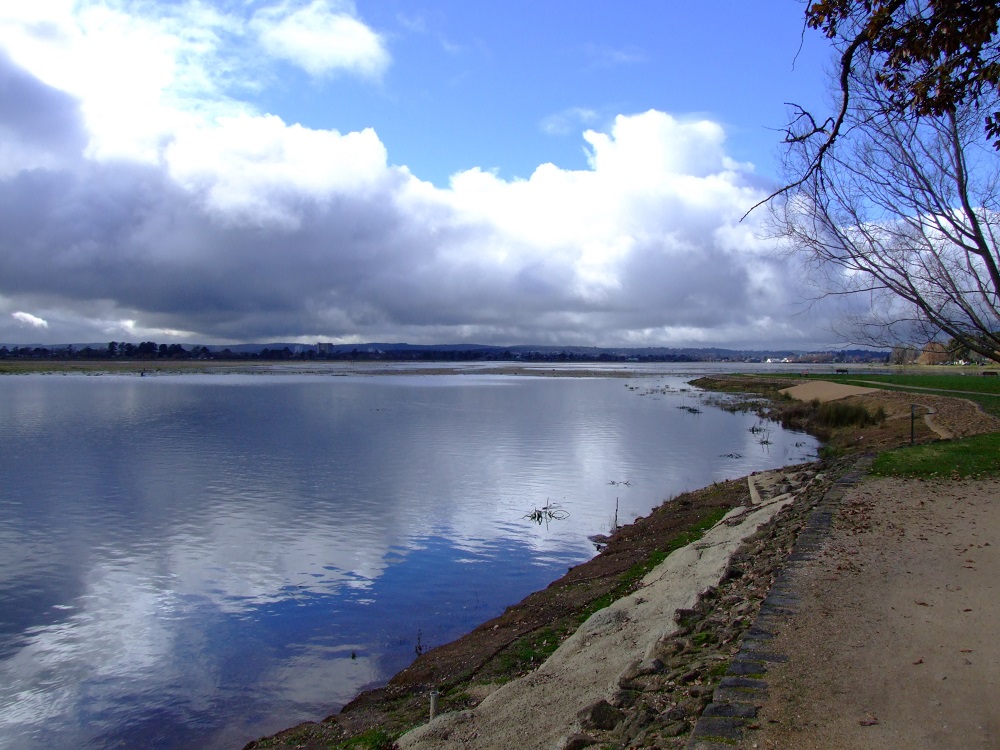 Lake Wendouree finally refilling in July 2010 after the devastating 'noughties' drought - pic taken from the end of the rowing course.
Lake Wendouree finally refilling in July 2010 after the devastating 'noughties' drought - pic taken from the end of the rowing course.Today ‘the lake’ (as locals simply call it) has a good population of both brown and rainbow trout. It also has a large head of redfin up to 50cm in length, as well as tench, which are only occasionally caught by flyfishers. A mostly shallow and fertile lake, Wendouree maintains plenty of aquatic invertebrates and forage fish, which provide an excellent food source for trout.
While often thought of as a boat fishing lake, Wendouree is also a good shore-based venue. It’s worth noting that for bank fishing, waders are basically unnecessary. There’s a firm and slightly elevated rock or concrete edge right around the lake, and deeper, fishable water is usually casting distance from the bank and various structures. In any case, wading is very uncomfortable on the soft, muddy bottom.
Mayfly, mudeyes and more
The event most keenly anticipated by bank and boat fishers alike, is the mayfly hatch which occurs through October and November and again around April. Although a day-to-day proposition depending on conditions (cloudy and humid days are most promising) these hatches of mayfly have almost recovered to full strength since the noughties drought, and they can rival the hatches on the highland lakes of Tasmania.
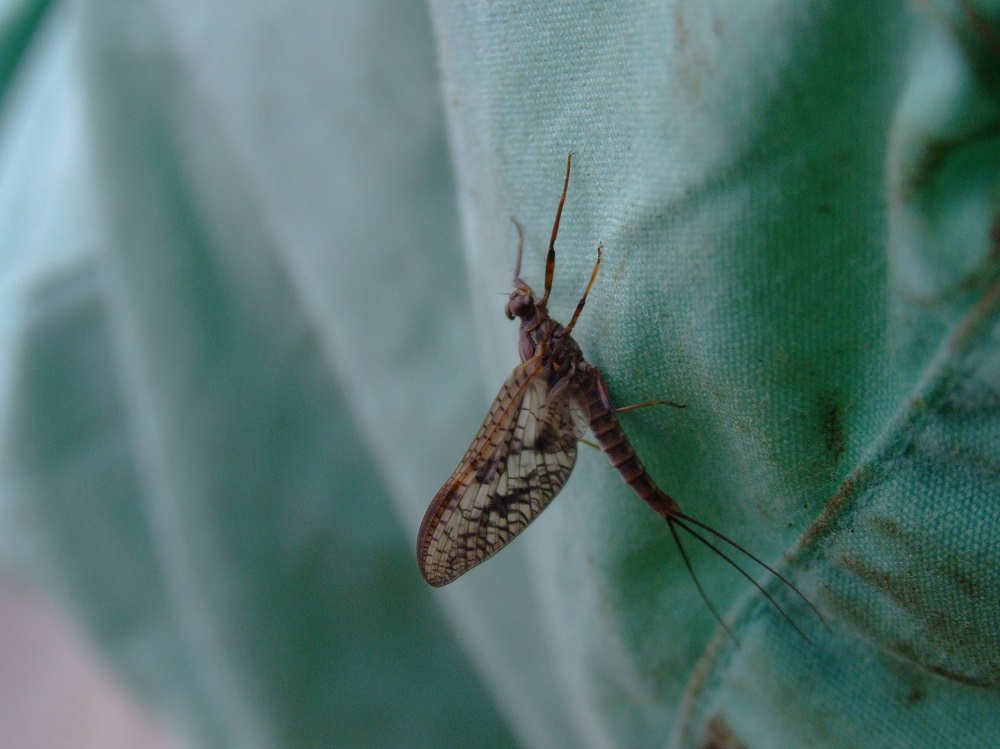 The Lambda dun (Atalophlebia australis) is the mayfly species responsible for Wendouree's dun hatches.
The Lambda dun (Atalophlebia australis) is the mayfly species responsible for Wendouree's dun hatches.Then there’s the after-dark mudeye emergence, which starts in November and lasts through until sometime in autumn. These events can also provide great fishing for the bank-based angler – in fact, bank fishing beats boat as the trout tend to focus on structure around the edges.
When these two highlights aren’t occurring, the trout in the lake are busy feeding on snails, stick caddis, midge and a range of baitfish. Day-time fishing does slow down during summer as water temperatures rise, although the mudeye fishing can persist on all but the hottest nights.
As a Ballarat native who grew up casting distance from the north shore of the lake, I doubt there is any part of Wendouree I haven’t thrown a fly into. (Or, in my younger days, a mudeye or cricket!) I’m often asked for advice on the best places on the lake for the bank-based angler, and this long-overdue article is my response. I’ve divided the lake into 13 sectors, which we will visit in a clockwise direction – starting where it all began for me on my boyhood ‘home shore’ on the north side at Fairy Land.
Naturally, all my observations and suggestions will be impacted by the time of year, prevailing weather and the presence of extensive weed growth – which varies annually and is impacted by weed cutter activity. (Mechanical weed-cutting barges operate on Lake Wendouree for lengthy periods each year – without them, the lake would soon be too weed-choked to sustain most aquatic activities, including fishing.)
Sector 1: Fairy Land to Durham Point
This sector is one of my favourites for bank fishing, as it's often protected from the wind, and tends to be free of excessive weed growth. From Fairy Land to the High School boatshed, trout feed between the bank and a permanent weed-bed located about a cast out from the bank. My largest Wendouree brown (67cm) was taken from this bank in November 2017. It was feeding along the weed-bed on duns. There is a launching ramp between the High School and Ballarat Grammar boatsheds, and my previous biggest Wendouree trout came from here after dark. It was feeding on migrating mudeyes.
Continuing east, the bay from the boatsheds to Durham Point can be very productive during mayfly time, and after dark for mudeye feeders.
Sector 2: Durham Point
As a boy I did most of my fishing here as my family home was just across the road. In fact, I caught my first trout off this point on a bunch of worms. This area is good to fish and in recent times, the pontoon to the right of the launching ramp (located on the eastern side of the point) has been producing action. This is particularly so in autumn and spring, as the mayfly hatches have been very good in this area lately and the pontoon gives the angler access to rising fish.
Sector 3: Durham Point to the start of the Rowing Course
Normally a weed cutter will do a couple of cuts here close to the shore early in the season. This can produce fine fishing as trout patrol along the newly-created channel. I have caught many fish here hard on the bank, and during a northerly in mayfly season, fish patrol this area looking for spinners. The eastern end of this sector sees large mudeye hatches during summer and is well worth a look after dark.
Sector 4: Start of Rowing Course
During the 'noughties' drought, extensive works were undertaken on the rowing course, including deepening the channel beneath the course. Two new points were also created on either side of the starting line. As a result, bank anglers here now have easy access to deeper, weed-free water. This makes this spot a worthwhile place to target generally, and especially as water temperatures increase during the warmer months, with the extra depth giving the trout some refuge from the heat. The point on the south side can produce good fishing for mayfly feeders during a westerly, as this blows the duns shoreward.
Sector 5: Start of Rowing course to Ballarat City boatshed
The main features along this shore are the Ballarat Fly Fishers T Casting Jetty, and the round outflow pipe which is located further south near the City boatshed. Once again, westerly winds will blow mayfly towards the shore and bring feeding trout within range. The jetty itself offers anglers even better access to these fish.
When the lake is full and overflowing, you can sometimes find concentrations of trout around the currents created near the outflow, particularly rainbows.
Sector 6: View Point
This is an excellent area for the shore-based flyfisher. Being a long, narrow point, it provides access to a range of environments. The bank is lined with a bluestone wall, which in a strong northerly or westerly, causes the waves to wash back on themselves, creating confused and rough water. Rainbows love these conditions and can often be caught as they charge around in the chop.
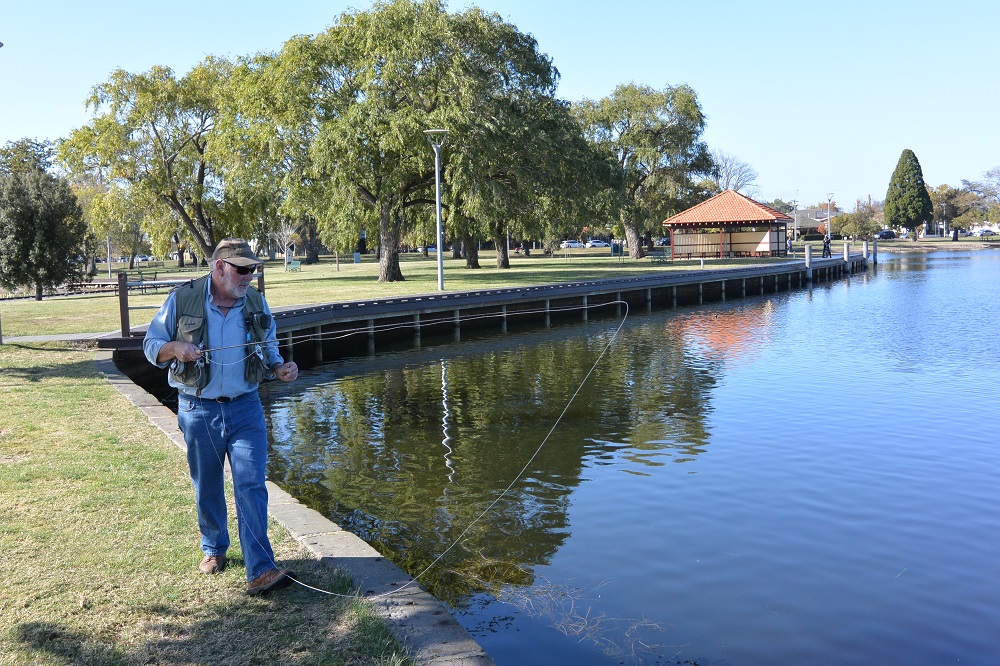 Looking for fish along the deep edges of View Point. These can come alive with mudeye feeders on warm nights from late spring onwards.
Looking for fish along the deep edges of View Point. These can come alive with mudeye feeders on warm nights from late spring onwards.View Point is also a good location for mudeye feeders after dark. As well as fishing straight out into the lake, it’s very important to put plenty of casts parallel to the bank, as the trout will cruise close to the edge looking for mudeyes migrating to shore.
Sector 7: Powerhouse Bay
This area used to be very productive during the summer months, when cool top-up water for the lake flowed from Gong Gong Reservoir and entered here. However, under Wendouree's new water management regime, this no longer occurs; instead, the summer lake level is maintained with a mix of bore water and recycled water. As a result, this area does not fish as well as it once did.
Sector 8: Southern boat ramp to St Patrick's College boatshed
This area can fish well at times and is reliable in calm conditions for spinner feeders. It’s also good after dark for mudeye feeders.
Sector 9: St Patrick's Point to end of Rowing Course
This is the most popular area for bank fishing. It is well protected from the prevailing westerly wind and has good, reliable mayfly hatches. The rowing pontoons at the western end of this section provide excellent platforms for anglers, and many quality fish have been taken from them since their installation. This whole area also fishes well after dark.
Sector 10: End of Rowing Course
As with the start of the rowing course (sector 5), the points on either side of this end of the Course provide good access to deeper water and are very popular places to fish. The best rainbow trout I’ve seen caught from the lake was taken from the northern side of this sector, commonly called 'the mud bank'. It was a beautifully-proportioned hen measuring 62cm.
Sector 11: End of the Rowing Course to the Hatchery Pump Pond
This area has poor water access and poor fishing.
Sector 12: Hatchery Pump Pond to the Swan Pond
This is a very special sector for me as it’s where, as a teenager, I caught my first trout on fly. It was a brown of about 3lb, caught (appropriately!) on a Craig’s Night-time during a mudeye hatch. This is still one of my favourite shores for chasing mudeye feeders. The water here is relatively clear of weed and possibly as a result, it does not have mayfly hatches. It does however boast large midge hatches, and it can fish well on calm winter evenings.
 Time for a fly change at Sector 12. Where else but Wendouree can you take a break from fishing on a comfortable seat, and maybe wander over to a nearby cafe for a mid-morning coffee break?
Time for a fly change at Sector 12. Where else but Wendouree can you take a break from fishing on a comfortable seat, and maybe wander over to a nearby cafe for a mid-morning coffee break?Sector 13: Fairy Land
Whilst being very attractive for a stroll, this is a poor fishing area.
Watch Your Back Cast!
Despite Wendouree’s reputation as a boat fishery, hopefully my notes above show it has real value as a bank-based venue too. Admittedly, the proximity of the lake to playgrounds, gardens, restaurants, cafes and walking tracks – not to mention a city of nearly 100,000 residents! – makes it an unusual place to fish. But don’t let the surrounds fool you, this is a top-class trout lake from bank as well as boat.
FLYSTREAM FACTS – GEAR
As I mentioned earlier, waders are not necessary to fish Lake Wendouree, although a long-handled landing net is handy. I use a 5 or 6 weight 9’6” rod, teamed with a floating line. To this I add a 9ft-plus tapered leader with 4 to 6lb tippet. During a mayfly hatch, I will often fish two flies, and during a mudeye hatch, I’ll boost the tippet to 8 or 10lb.
FLYSTREAM FACTS – WENDOUREE FLY BOX
My favourite Wendouree flies are:
Mayfly season:
Claret Shuttlecock - size 12, Claret Possum Emerger - size 12, Grey Para Dun - size 12, brown or claret nymphs - size 12.
All-round searching & smelters:
Wendouree Cruncher - size 12, lightly-weighted Magoo with copper or orange bead - size 10, Tom Jones - size 8, Scintilla Stick Caddis - size 12.
After-dark mudeye hatches:
Craig’s Night-time - size 8, Black Muddler - size 8.





